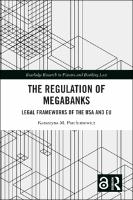The Regulation of Megabanks
Proposal review
Legal frameworks of the USA and EU
| dc.contributor.author | Parchimowicz, Katarzyna | |
| dc.date.accessioned | 2022-11-16T09:00:51Z | |
| dc.date.available | 2022-11-16T09:00:51Z | |
| dc.date.issued | 2023 | |
| dc.identifier | OCN: 1349650818 | |
| dc.identifier.uri | https://library.oapen.org/handle/20.500.12657/59248 | |
| dc.description.abstract | Global systemically important banks (G-SIBs) are the largest, most complex and, in the event of their potential failure, most threatening banking institutions in the world. The Global Financial Crisis (GFC) was a turning point for G-SIBs, many of which contributed to the outbreak and severity of this downturn. The unfolding of the GFC also revealed flaws and omissions in the legal framework applying to financial entities. In the context of G-SIBs, it clearly demonstrated that the legal regimes, both in the USA and in the EU, grossly ignored the specific character of these institutions and their systemic importance, complexity, and individualism. As a result of this omission, these megabanks were long treated like any other smaller banking institutions. Since the GFC, legal systems have changed a lot on both sides of the Atlantic, and global and national lawmakers have adopted new rules applying specifically to G-SIBs to reduce their threat to financial stability. This book explores whether the G-SIB-specific regulatory frameworks are adequately tailored to their individualism in order to prevent them from exploiting overly general rules, as they did during the GFC. Analyzing the specific character and individualism of G-SIBs, in relation to their history, normal functioning, as well as their operations during the GFC, this book discusses transformation of banking systems and the challenges and opportunities G-SIBs face, such as Big Tech competitors, climate-related requirements, and the COVID-19 pandemic. Taking a multidisciplinary approach which combines financial aspects of operations of G- SIBs and legal analysis, the book describes G-SIB-oriented legal frameworks of the EU and the USA and assesses whether G-SIB individualism is adequately reflected, analyzing trends in supervisory action when it comes to discretion in the G-SIB context, all in order to contribute to the ongoing discussions about international banking law, its problems, and potential remedies to such persistent flaws. | en_US |
| dc.language | English | en_US |
| dc.relation.ispartofseries | Routledge Research in Finance and Banking Law | en_US |
| dc.subject.classification | thema EDItEUR::L Law::LA Jurisprudence and general issues | en_US |
| dc.subject.classification | thema EDItEUR::L Law::LN Laws of specific jurisdictions and specific areas of law::LNP Financial law: general::LNPB Banking law | en_US |
| dc.subject.classification | thema EDItEUR::L Law::LN Laws of specific jurisdictions and specific areas of law::LNC Company, commercial and competition law: general | en_US |
| dc.subject.other | Jurisprudence and general issues;Banking law;Company, commercial and competition law: general | en_US |
| dc.title | The Regulation of Megabanks | en_US |
| dc.title.alternative | Legal frameworks of the USA and EU | en_US |
| dc.type | book | |
| oapen.identifier.doi | 10.4324/9781003276883 | en_US |
| oapen.relation.isPublishedBy | 7b3c7b10-5b1e-40b3-860e-c6dd5197f0bb | en_US |
| oapen.relation.isFundedBy | e22a39e5-184e-4325-98c2-dad88b1d2d9f | en_US |
| oapen.relation.isbn | 9781000799057 | en_US |
| oapen.relation.isbn | 9781032233475 | en_US |
| oapen.relation.isbn | 9781032233550 | en_US |
| oapen.imprint | Routledge | en_US |
| oapen.pages | 246 | en_US |
| peerreview.anonymity | Single-anonymised | |
| peerreview.id | bc80075c-96cc-4740-a9f3-a234bc2598f1 | |
| peerreview.open.review | No | |
| peerreview.publish.responsibility | Publisher | |
| peerreview.review.stage | Pre-publication | |
| peerreview.review.type | Proposal | |
| peerreview.reviewer.type | Internal editor | |
| peerreview.reviewer.type | External peer reviewer | |
| peerreview.title | Proposal review | |
| oapen.review.comments | Taylor & Francis open access titles are reviewed as a minimum at proposal stage by at least two external peer reviewers and an internal editor (additional reviews may be sought and additional content reviewed as required). |

